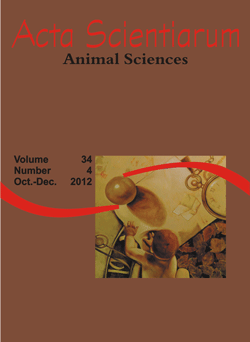<b>Bromatological characterization of maize genotypes for silage</b> - doi: 10.4025/actascianimsci.v34i4.15271
Abstract
Since every year public and private companies bring many genotypes of maize to the market, the suitability of these genotypes for the production of silage should be evaluated. Current study evaluates the agronomic and chemical characteristics of early-normal cycle maize genotypes as well as assesses whether the genetic bases (single, double, and triple hybrids, as well as varieties and intervarietal genotypes) and the grain hardness (hard, semi-hard and dentate) modify the indication of maize genotypes for silage. The experiment was conducted at the Universidade Tecnológica Federal do Paraná, campus Dois Vizinhos, Paraná State, Brazil. Thirty-six genotypes were evaluated by a simple lattice design. Grains were harvested at the pasty to farinaceous stage and stored in micro-silos of 100-mm PVC, for 60 days. Neither the different genetic bases nor the different textures of the genotypes influenced the indication of maize genotypes. The early-normal cycle maize genotypes behave similarly for most characteristics assessed, except for the stem diameter and stem dry matter. Moreover, most maize genotypes have suitable characteristics for the production of high-quality silage.
Downloads
DECLARATION OF ORIGINALITY AND COPYRIGHTS
- I Declare that current article is original and has not been submitted for publication, in part or in whole, to any other national or international journal.
The copyrights belong exclusively to the authors. Published content is licensed under Creative Commons Attribution 4.0 (CC BY 4.0) guidelines, which allows sharing (copy and distribution of the material in any medium or format) and adaptation (remix, transform, and build upon the material) for any purpose, even commercially, under the terms of attribution.
Read this link for further information on how to use CC BY 4.0 properly.








































